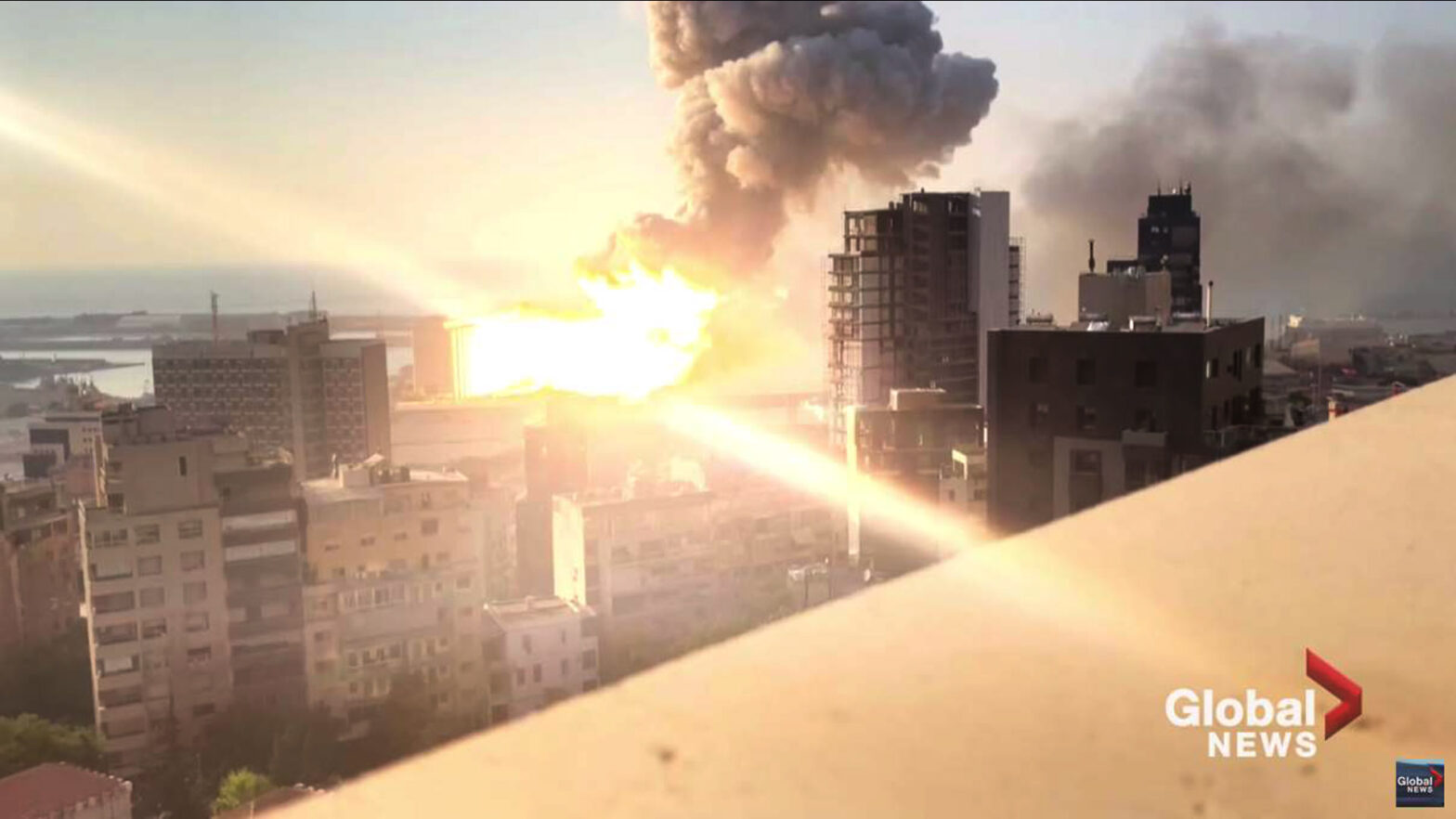Current extreme tensions between the Lebanese Resistance and 'Israel' have the potential to lead to a violent explosion across all of West Asia. As Israel increasingly comes to realise it cannot prevail in this war, and may have to face the consequences of its extraordinary crimes, its incentive to 'go nuclear' is considerable, despite the disastrous consequences for the whole region and a likely reaction that would see an end to the whole wretched Zionist project. This possibility - that Israel would decide to use its much vaunted nuclear weapons to cast a decisive blow against Hezbollah in South Beirut or South Lebanon - is made more likely if one considers that the Zionists already used some sort of nuclear device when the port of Beirut was destroyed on August 4th 2020 - a massive explosion heard and felt all across the region, and the 'biggest non-nuclear explosion ever recorded'. At the time, after some critical research and examination of videos of the blast, I concluded that it was a nuclear device from a number of 'signature' features of the explosion. I wrote the following article for American Herald Tribune, which is still available in the web archive at this address. I republish it below however, with additional video extracts, and links to information that has emerged since from the researches of Bruce Baird.
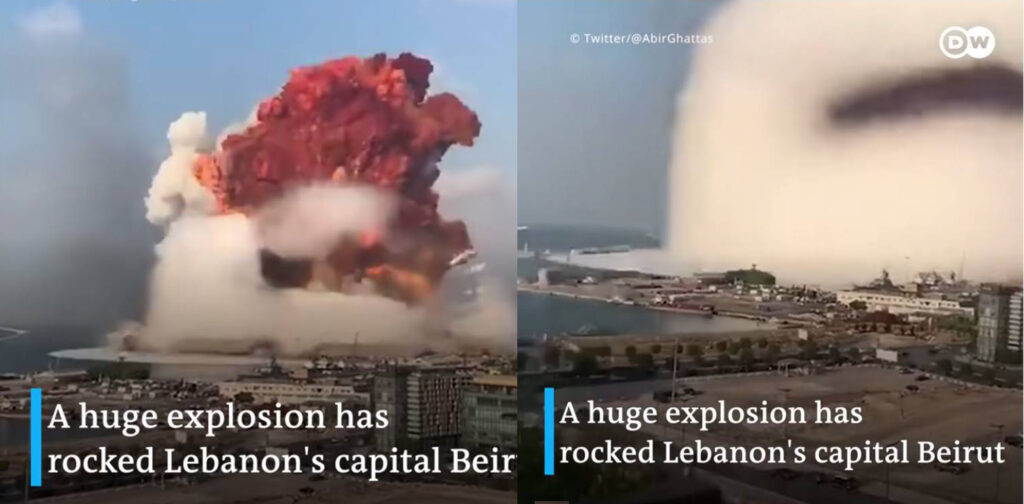
The Nuclear Signature of the Beirut Blast. Amongst the plethora of theories on the cause of the Beirut explosion of August 4th, and justifiable suspicions that it was not entirely an accident, one theory was quickly ruled out. Thanks to the unusual mushroom-shaped appearance of the blast wave that preceded the explosion of a warehouse full of Ammonium Nitrate, many observers immediately thought of the “iconic” Bikini Atoll nuclear tests, and wondered if one of the usual suspects had tried out a new weapon. The timing was odd too – two days before the 75th anniversary of the flattening of Hiroshima by an American nuclear bomb. As the dazed citizens of Beirut saw what had happened to their city, images of the blast and its devastating result appeared in news bulletins around the world alongside those of Hiroshima, with the surviving walls of the grain silo at “ground zero” reminiscent of Hiroshima’s still standing clock tower. More pointedly, the explosion came just before the final release of the UN Investigative Tribunal’s report into the 2005 Hariri bombing. Despite immediate accusations against Hezbollah for storing weapons at the port from people desperate to shift the blame, it soon became clear that the port area was under control of Hezbollah’s chief opponents allied to Saad Hariri. Given what we know about the Rafiq Hariri bombing – as comprehensively analysed by Jeremy Salt – this is a detail to keep in mind. As details began to emerge about the storage of 2,750 tonnes of “Nitropril” at the port, and the strange way it came to be there, the wrath of Beirut’s suffering citizens turned toward the government, and the perceived corruption that had allowed this explosive time bomb to sit there so close to the heart of the city for seven years. Speculation on the cause of the blast wave that did most of the damage was mostly limited – in the mainstream media at least - to how the Nitropril had come to be ignited. Despite lingering suspicions and speculation in independent media on “cui bono”, fuelled by apparent celebration in some quarters, a tragic accident combined with incompetence and corruption seemed most likely. Until now that is – for this observer. Ironically it is two “pro-Israel” articles that have led to my own observations and investigation of the possibility that something else detonated in Warehouse 12 which caused the blast wave, and whose presence was overlooked in the shock of the moment and in the various videos of the incredible explosion. Until now that is – for this observer. Ironically it is two “pro-Israel” articles that have led to my own observations and investigation of the possibility that something else detonated in Warehouse 12 which caused the blast wave, and whose presence was overlooked in the shock of the moment and in the various videos of the incredible explosion. The first of these from Richard Silverstein, claimed that Israel had bombed Beirut, targeting a Hezbollah weapons store, and setting alight the Nitropril unintentionally. This story was rapidly dismissed for obvious reasons, but was headed by a photograph showing the white mushroom cloud expanding around a red-brown exploding column. But it also shows something quite strange – a white disc near ground level, oddly reminiscent of something we have all seen, both in classic space movies and in real-life. Although the sci-fi movie versions are only loosely based on astronomical phenomena, and called “the Praxis Effect” on that basis, the phenomenon of a disc-shaped shock wave is associated with some nuclear explosions. The most famous of these was the “Baker” test at Bikini Atoll in 1946, which can be seen in this video clip – and a hundred others – as well as in the still shot below:
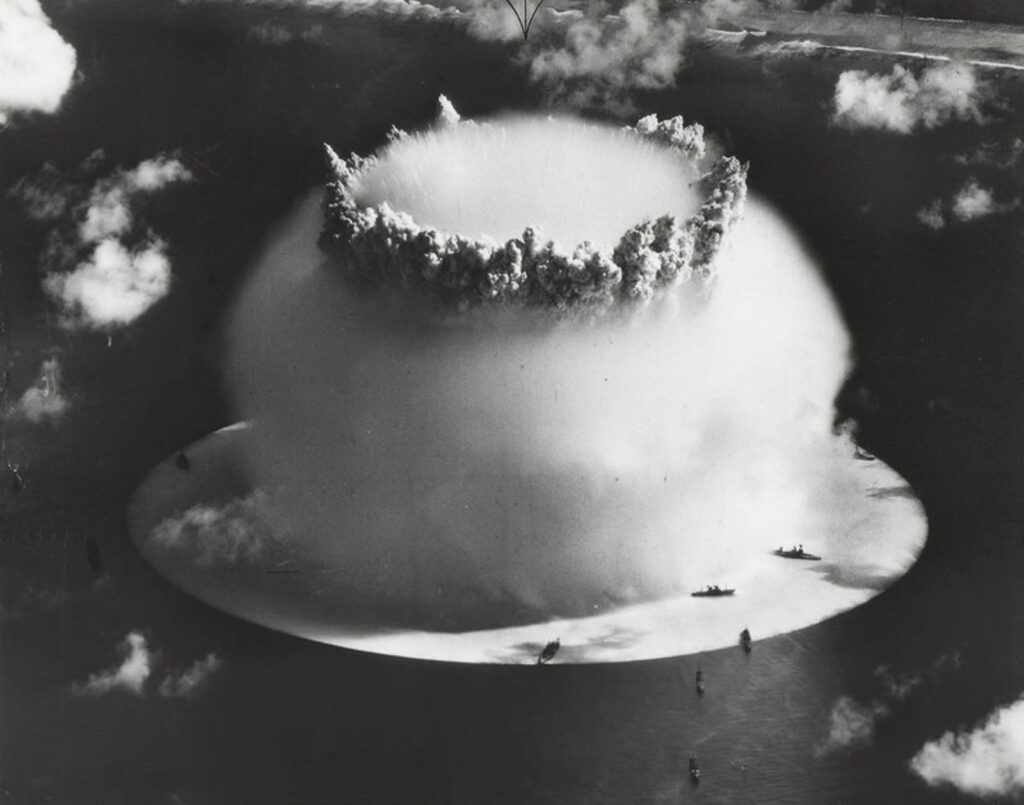
Viewing the video from which the frame illustrating Silverstein’s article came (also seen here)(but now here in the Web Archive) shows a chilling similarity to that shock wave from the Baker test, though it has significant differences which need interpretation by an independent expert – if such a person can be found! The Baker test was detonated underwater, ejecting two million tonnes of seawater up through a flotilla of abandoned ships. While the familiar mushroom cloud formed above the surface it was the expanding shock wave beneath that caused the white disc in the surface waters. The expanding disc seen in the Beirut blast is however not just some optical phenomenon, apparently advancing ahead of the mushroom-shaped cloud above and about 20 or 30 metres from ground level. At the end of the DW news video the disc spreads over a ship in the harbour, reminding one further of the Baker test. A wave of turbulence can also be seen following behind the disc edge, before the blast wave reaches the camera. Two views of the expanding disc are shown in the photo leading this article, which are screen shots from the video below, taken from a DW news report and played back at quarter speed:
A fair bit has been written about the explosive behaviour of Ammonium Nitrate, questioning everything from the quantity needed to cause such a blast, its ability to create such a percussive explosion, and even claims the explosion was of other materials altogether. One such claim has been made by an Italian explosives expert of repute, who rightly observes that such a quantity of Nitropril could not be made to explode in one short blast, but the article then goes on to claim Iranian weapons containing lithium were responsible. The Lebanese website’s reference to Al Arabiya, and claims the port was completely controlled by Hezbollah make nonsense of the Italian’s expert opinion. Of far more interest however is the view of numbers of scientists quoted by Business Insider, who agree the Beirut blast could not have been nuclear, based on its lack of some signature features. In particular the failure to see a blinding flash of light from a nuclear detonation confirms their opinion, and might have confirmed mine had it not been for one frame in another video shown on the Global News channel. The same sequence showing the fire before the detonation and the blast following it, is repeated several times with a slowed version at the end. (the same video clip, published by Al Arabiya, includes an even slower speed section, making the flash and fireball clearly visible. (update 6/24)) The slow sequence in this video shows quite clearly a blinding flash, but only visible in a single frame before a fireball forms, followed by the mushroom cloud blast wave. Three frames from the sequence are included below, as shown in the lead picture for this article, along with one of the developing blast wave:

We are left to speculate on what sort of explosive or weapon created this blast, remembering that it was reportedly heard as far away as Cyprus, and felt like an earthquake in the region. Interestingly also it left behind a sizeable crater well below sea level, as visible now in shots from the air. But one thing seems certain – that Hezbollah had neither the means nor motive to place a tactical nuclear device in the heart of Beirut. Nor would Hezbollah ever stoop to commit such an act of treachery even if it had the means and motive, not even against its mortal enemies. Clearly the same cannot be said of 'Israel', for whom treachery and lies are the established and proven modus operandi, embedded in Mossad's oath - "by means of deception shalt thou prevail". First Postscript: Given the contentious nature of these claims, it’s important to make as much as possible of the observed phenomena – which in the absence of credible and impartial investigation is all we have to go on. The “investigation” now to be conducted by the FBI can only be expected to further obscure the truth, if that truth implicates Israel and exonerates Hezbollah. Shortly after writing this article, I realised that I had made an error in interpreting the expanding white disc seen in the first video sequence, seeing it as a blast wave in the air some metres above the surface. On locating film of the Baker nuclear test, I was surprised to find that the similar white disc following the detonation was actually on the ocean surface, and caused by the shock wave beneath, and so could not say this feature was another “signature” of a nuclear explosion present in the Beirut blast. Wrong conclusion! Further close observation of the Beirut “crack” reveals that it is in fact an identical phenomenon to that at Bikini Atoll, and is a surface disturbance in the water in the port. This is confirmed when the disc is seen to reach the ship at the end of the video clip as the disc passes beneath it. I had also wrongly assumed that the white disc was only visible over the harbour because the view was obstructed in the foreground. Whether such a shock wave could have resulted from the explosion of 2700 tonnes of Ammonium Nitrate is “unclear” – though seems improbable. Where the shock wave appears in the water it had to already pass through the ground beneath the grain silos, yet appears very similar to the nuclear bomb-induced “crack”. Most notably, people in Beirut well beyond the range of the aerial blast wave described feeling an earthquake, and this may well have been responsible for much of the structural damage to buildings. The blast was indeed recorded up to 1000 kms away by seismic monitors, as discussed here. Whether this blast had a “nuclear signature” they aren’t saying. End of original article from 16th August 2020; current postscript below.
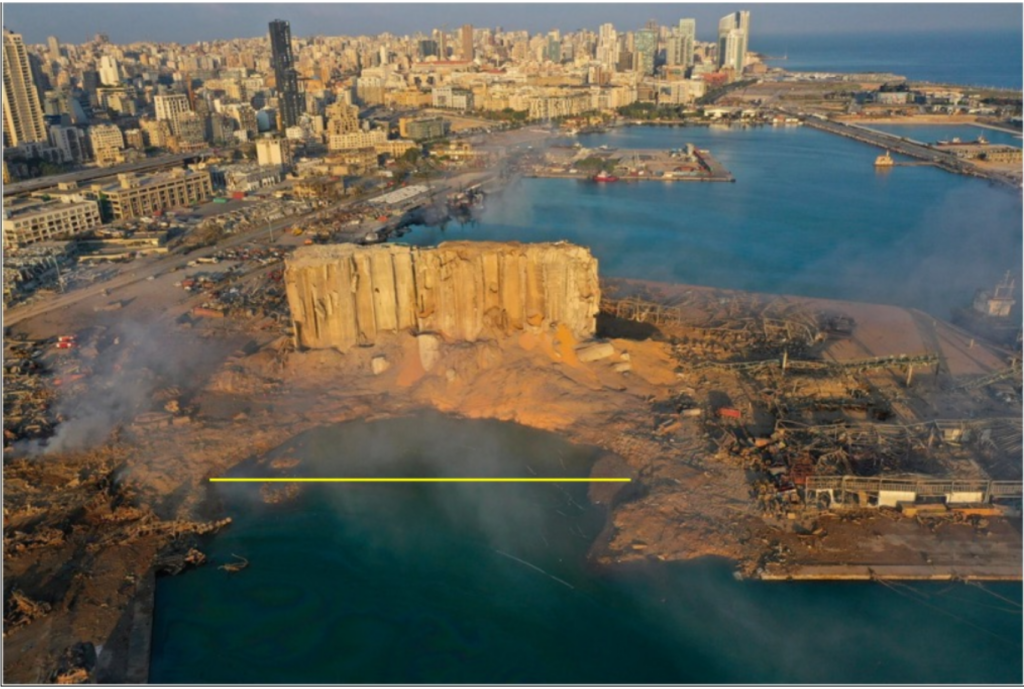
As noted above, in the nearly four years since the explosion some further information has come to light and been studied by investigators, such as Dr Bruce Baird, who in this article draws together a number of sources and threads to support his conclusion - that the observed explosion and its consequences could not have been created by anything other than some sort of nuclear device, and certainly not by the explosion of 2,750 tonnes of Ammonium Nitrate. Those 'researchers' such as Bellingcat, to whom we owe the photo above and measurement of the crater, can only claim the explosion was non-nuclear because they can't imagine or admit that it could have been an act of State Terrorism committed by the only nuclear-armed power in the region with the ability and motive to commit such a crime. Although there were some dubious videos or photos posted after the attack claiming to show a missile heading for the port, this means of delivering a nuclear device seems very unlikely in the context of the time. The alternative may seem unpalatable given it would mean collaboration with local agents in Beirut, but the shipping in and placing of such a device could have been done in advance without attracting any attention. The FBI report - needless to say - only found evidence to confirm the Nitropril theory. There was a strange and inexplicable sequel to this story; just at the time of a commemoration of the disaster in Beirut, and anger over the ongoing economic crisis in Lebanon, part of the damaged grain silos suddenly collapsed - on August 4th 2022. While a fire had been smouldering for weeks in the depths of the grain pile, the timing of this event seems beyond coincidence, and only reinforces suspicions about covert activities in the port of Beirut.
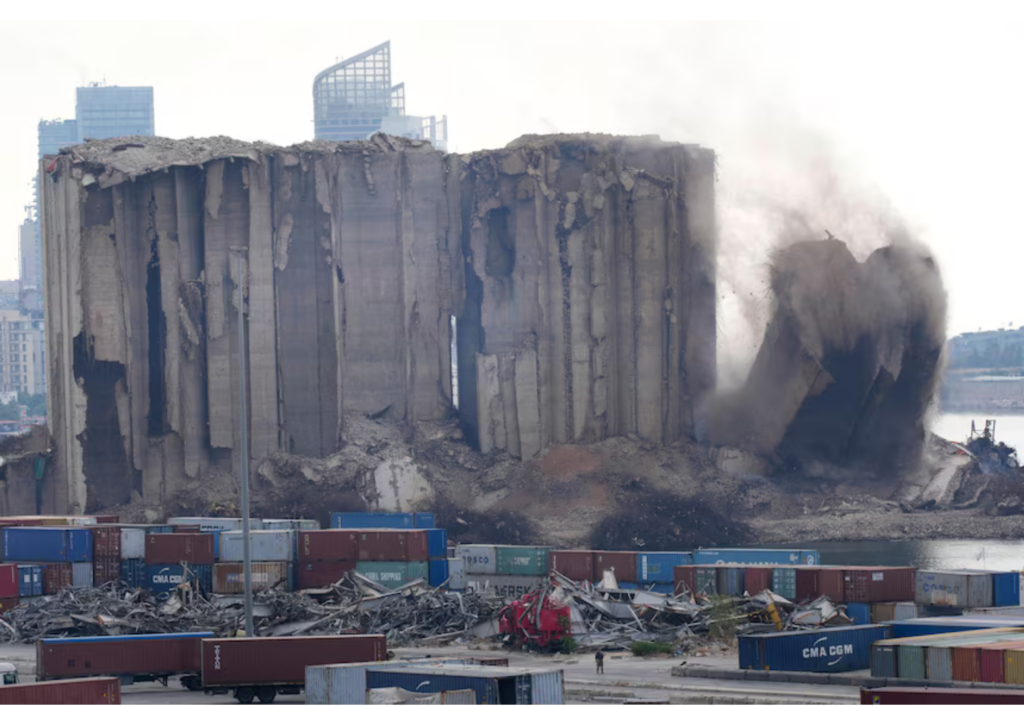
DM 29th June 2024
